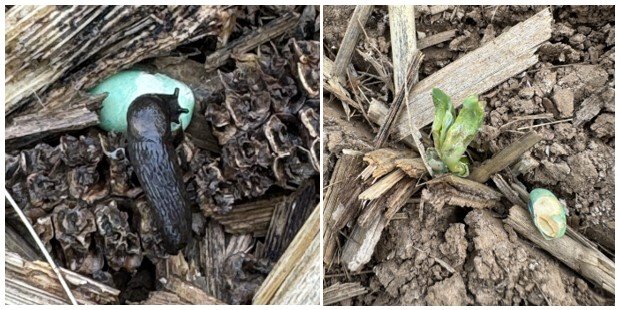Beet and Yellow-Striped armyworms present in Kentucky fields.
Read MoreRecent correspondence with County Extension Agents, growers, and Extension colleagues in forage indicated a surge of fall armyworms (FAW) (Spodoptera frugiperda, Noctuidae) in forages. These reports originate from various regions of Kentucky, beginning in August and continuing until the first week of September.
Read MoreThere are multiple foliar diseases confirmed in Kentucky corn fields this year. Some are familiar and annually important diseases like gray leaf spot and southern rust, but newer diseases are also present in several areas of the state.
Read MoreSince the end of March and the first week of April we have been observing slugs in various stages of development as well eggs in soybean and corn fields.
Read MoreThis is the time of the year when contest-winning corn and soybean yields are announced. Some of the winners set records for the highest yield ever – yields that can be as much as 3 or 4 times the average U.S. yield. Yields that high bring to mind the silver bullet syndrome…
Read MoreOver 50% of the years in the past decade have been exceptionally wet at/near planting. These conditions complicate early corn nitrogen (N) nutrition management.
Read MoreBoth corn and soybean finished strong across Kentucky despite lower total rainfall amounts across most of the state. The 2023 Kentucky corn crop is estimated by the Kentucky Office of the United States Department of Agriculture National Agricultural Statistics Service (USDA-NASS) at 183 bushels per acre, up 17% from 2022, making the second largest corn crop on record.
Read MoreKentucky corn and soybean yields this year were better than many expected. They didn’t set records, but they were close.
Read MoreOctober 31st marks the end of the harvest price discovery period for revenue protection crop insurance policies. The harvest price is used to calculate crop insurance indemnity payments and is the average December corn and November soybeans futures settlement prices during October.
Read MoreSouthern rust of corn, caused by the fungus Puccinia polysora, was confirmed in Kentucky on August 8, in Todd County. As of August 8, we have only confirmed the disease in Todd County, but with our current weather conducive for disease development, it will not be surprising to see additional confirmations across the state.
Read MoreEither corn or soybean fully submerged more than 24 hours in these temperatures likely died. Plants in fields flooded for about 48 hours or more - even with plants exposed - likely will die. Generally, the area of plant death is larger than we initially estimate. If the water was over the ears for about 24 hours, then the ears are lost. They very likely have started to rot by now.
Read MoreThe dry weather across the state is putting stress on the corn crop. The lack of water to corn before the V12 growth stage usually results in minimal yield losses if adequate water occurs at V12 and beyond. Most of the corn in Kentucky ranges from just planted to about V9 as of June 5, 2023.
Read MoreFreezing temperatures were recorded across Kentucky Monday morning, April 24, 2023. The coldest temperatures were mostly in central and eastern Kentucky, but freezing temperatures were as far west as Trigg and Webster counties.
Read MoreCorn planting is underway in western Kentucky, and the number of acres should increase rapidly this week. In most years, the weather, forecast, and soil conditions are more important than the calendar for planting corn.
Read MoreCongratulations to Tanner Stroup (Daviess Co.) and Kevin Hayden (Carlisle Co.) for achieving 300+ yields in this year’s contest.
Read MoreAbout 66% of the Kentucky corn crop underwent water stress during the worst possible time. The only management option that would have helped at this time was irrigation. If a farmer could not irrigate, then no management was going to fix this problem.
Read MoreTar spot on corn was confirmed by the University of Kentucky Plant Disease Diagnostic Laboratory (PDDL) from samples collected in Lincoln County. This is our first confirmation of tar spot for 2022, after finding it in Ohio and Todd counties in 2021.
Read MoreThese specimens were identified as the dusty corn sap beetle. Sap beetles are secondary pests of corn. They are opportunistic invaders that detect damage by other pests.
Read More

















